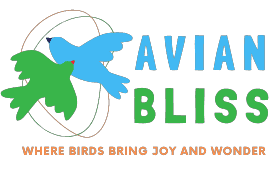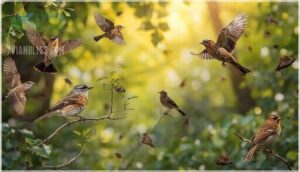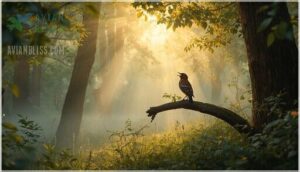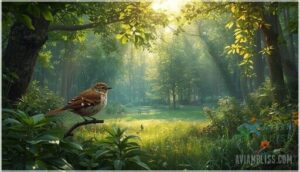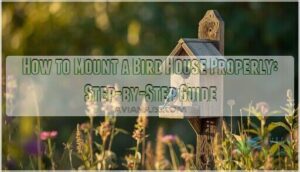This site is supported by our readers. We may earn a commission, at no cost to you, if you purchase through links.
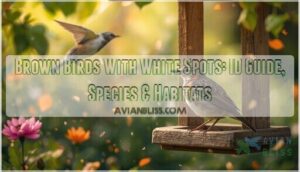
Dozens of brown birds wear white-spotted plumage, from the melodious Wood Thrush scratching through leaf litter to the scrappy House Sparrow claiming your porch as territory. Each species tells a different story through its spots: some display bold chest streaks that advertise breeding fitness, while others hide cryptic flecks that vanish against dappled forest floors.
Learning to decode these patterns transforms a fleeting glimpse into a confident identification, revealing which travelers have stopped at your yard and what their presence says about the landscape around you.
Table Of Contents
- Key Takeaways
- Brown Birds Overview
- Identifying Brown Birds
- Brown Birds With White Spots
- Brown Bird Habitats
- Bird Watching Tips
- Frequently Asked Questions (FAQs)
- Are brown birds with white spots common?
- Which bird has white spots?
- Why do brown birds have white spotting?
- Where do brown birds live?
- What birds are brown in color?
- Do thrush birds have white spots?
- What are the brown birds with white spots?
- Why do I have a brown thrasher in my yard?
- What is a brown bird with white speckled breast?
- What birds are brown with white?
- Conclusion
Key Takeaways
- Brown birds with white spots use their unique plumage for both camouflage and mate recognition, making each pattern a vital clue for identification.
- Habitat diversity—from dense forests to backyard gardens—shapes where you’ll find these birds, with native plants and ground-level feeders attracting more species.
- Spotting and identifying these birds hinges on noticing details like beak shape, spot distribution, and behavior such as ground-scratching or song patterns.
- Conservation efforts and thoughtful yard design directly impact the survival and visibility of brown birds with white spots, especially as habitat fragmentation threatens their populations.
Brown Birds Overview
Brown birds with white spots aren’t just background noise in your backyard—they’re a gateway to understanding the wild world right outside your door.
Brown birds with white spots open a window to the hidden wild world just beyond your backyard
These spotted wanderers carry stories in their feathers, from survival strategies to ancient migration patterns.
Let’s break down what makes these birds tick, starting with their most defining traits.
Physical Characteristics
Feather patterns tell you everything you need to know. When you’re scanning brown birds with white spots, zero in on the physical traits that separate one species from another—size, plumage colors, beak shapes, and those telltale spot markings that define each bird’s identity.
- Size and weight: Brown Thrashers span 9.3–12 inches with wingspans up to 13 inches, while compact Sedge Wrens measure just 4.3 inches.
- Spot markings and plumage colors: Wood Thrushes display symmetrical dark spots on white chests; Brown Thrashers show teardrop-shaped streaks across buffy underparts.
- Beak shapes: Long, downcurved bills distinguish thrashers from sparrows’ short, stout bills.
- Wing structures: Song Sparrows feature broad wings; Sedge Wrens have compact bodies with short, upturned tails.
Habitat and Distribution
Understanding where these birds live unlocks better identification—beak shapes only tell part of the story. Brown birds with white spots occupy everything from dense forest ecology to urban landscapes.
Brown Thrashers stick to shrublands and woodland edges across the eastern U.S., while House Sparrows dominate cities worldwide. Migration patterns matter too: some species shift hundreds of kilometers seasonally.
Habitat fragmentation threatens populations, especially ground thrushes now confined to isolated forest remnants. Conservation efforts focus on protecting wildlife habitat diversity, which directly impacts where you’ll spot these bird species in the wild.
Behavioral Patterns
Where these birds live shapes how they act—habitat drives survival. Thrushes spend roughly 70% of their time foraging on the ground, extracting insects from soil while occasionally hovering midair. Their seasonal diet shifts dramatically, leaning 80% toward animal matter in warmer months and pivoting to 60% fruit come fall.
Watch for these behavioral patterns:
- Foraging Strategies: Hop-and-scratch movements uncover seeds beneath dense underbrush
- Territorial Behaviors: Males defend 50–100 meter territories through dawn and dusk songs
- Mating Rituals: Tail-flicking displays startle prey and attract mates simultaneously
- Social Interactions: Some species exhibit aggressive song rates tripling during intrusions
- Nesting Habits: Ground-level or low-platform sites reflect natural invertebrate hunting
Understanding avian behavior patterns transforms bird watching tips into Wildlife Identification expertise. The Hermit Thrush exhibits unique breeding territory characteristics that influence its behavior.
Identifying Brown Birds
Spotting a brown bird with white markings isn’t the challenge—figuring out exactly what you’re looking at is where things get interesting. The real trick lies in knowing which features matter most and how to avoid the common mix-ups that trip up even experienced birders.
Let’s break down the field marks, look-alikes, and plumage details that’ll help you pin down your identification with confidence.
Key Features and Markings
When you’re sorting through brown birds with white spots, think of plumage patterns as fingerprints—each species tells its own story. Focus on spot distribution first: Wood Thrushes show dark brown spots covering roughly 40% of their white belly, while Spotted Towhees flash white wing spots averaging 4–7 mm each.
Check beak shapes next—thick bills signal seed-crackers, slender ones point to insect hunters.
Notice feather textures and how camouflage strategies work: those dappled markings aren’t random; they’re survival tools perfected over millennia for bird identification and species identification success. Understanding bird species habits is vital for effective identification and conservation efforts.
Similar Species and Misidentifications
Even experienced observers mix up Brown-headed Cowbirds with Song Sparrows, or confuse Brown Thrashers for Wood Thrushes when lighting’s poor. Misclassification rates spike with similarly-colored species, especially juveniles. Watch for these common pitfalls:
- Plumage Variations: Molting and age blur key field marks
- Species Overlap: House Finches mimic blackbird streaking patterns
- Identification Challenges: Dense vegetation obscures diagnostic spots
- Observer Bias: Experts sometimes force rare IDs onto common brown birds
White spots aren’t always obvious—wet feathers mask them completely.
Unique Plumage Patterns
Patterns like barred wings, mottled backs, and scattered breast spots tell you far more than simple field marks. White spotting functions in both camouflage tactics and mate recognition—you’ll find spotted plumage patterns in roughly 36% of small songbirds, driven by plumage genetics tied to the melanocortin receptor gene.
Brown Thrashers show bold streaking, while Spotted Towhees flash white wing spots during flight. These coloration adaptations reflect feather structure at the microscopic level—air pockets create structural whites that appear 22% brighter in low light.
Regional differences emerge too: precipitation shapes spot density, making bird identification context-dependent across habitats.
Brown Birds With White Spots
Once you recognize the telltale pattern of brown plumage dotted with white spots, you’ll start noticing these birds everywhere—from your backyard feeders to woodland trails. The trick is learning which species you’re actually looking at, since several bird families share this subtle but striking pattern.
Let’s break down the most common brown birds with white spots you’re likely to encounter, grouped by family and habitat.
Thrushes and Their Songs
When you hear that flute-like “ee-oh-lay” echoing through eastern forests, you’re likely encountering thrushes—masters of bird vocalization among brown birds with white spots. These skilled performers create song patterns with striking complexity, with individual males singing over 100 unique phrases.
Understanding brown thrasher mimicry and thrush song learning helps sharpen your bird identification skills in the field.
- Wood Thrush delivers melodious songs during summer breeding, a hallmark of thrush behavior.
- Hermit Thrush populations remain stable at 70 million, adapting well to human-altered landscapes.
- Thrush Migration occurs nocturnally, guided by stars and magnetic fields for habitat conservation across continents.
Sparrows and Their Species
Sparrows navigate the landscape like seasoned travelers—some species journeying thousands of miles during Sparrow Migration while others hold their ground year-round.
You’ll spot Song Sparrows with their heavily streaked breasts and central chest spot across diverse habitats, from wetlands to your backyard shrubs. The Spotted Towhee brings drama with bold white spots punctuating its dark wings.
These brown birds exhibit striking Species Diversity in Nesting Habits and Feather Patterns, making Bird Conservation efforts essential as populations face mounting pressures from habitat loss.
Other Brown Birds With Spots
Beyond thrushes and sparrows, you’ll discover brown birds with white spots that break the mold. The Brown Thrasher showcases rufous-brown plumage with bold black streaks across white underparts—a master of mimicry inhabiting dense shrubs. Spotted Towhees scratch through leaf litter with distinctive double-kicks, their white wing spots flashing during foraging.
For Bird Identification, note Feather Patterns: spot breeding plumage often intensifies during mating season. The Brown Finch and Whitethroated Sparrow display regional variations worth tracking.
These Brown Birds demonstrate diverse Spotting Techniques—some species migrate thousands of miles while others remain year-round residents, making Bird Migration patterns essential knowledge for serious observers.
Brown Bird Habitats
Where you spot brown birds with white spots depends entirely on the landscape they call home. From dense woodlands to your own backyard, these birds adapt to different environments based on their feeding habits and nesting needs.
Let’s explore the three main habitats where you’re most likely to encounter them.
Forests and Woodlands
Forests act like natural sanctuaries for brown birds with white spots—think of them as layered ecosystems where the Wood Thrush, Northern Flicker, and Brown Thrasher thrive. You’ll find these birds where mature tree canopy meets dense understory, especially in forests with high deciduous proportions that boost avian migration corridors and brown birds diversity.
Habitat fragmentation poses real threats, though—woodland conservation efforts focus on preserving large, connected tracts since Forest Ecology studies show bird density drops as forests shrink and fragment, impacting species that depend on old-growth stands.
Backyards and Gardens
Your backyard can become a haven for brown birds with white spots—think Wood Thrush, Spotted Towhee, and Brown Thrasher. Garden Design matters: you’ll attract 64% more thrushers with the right setup. Start with these steps:
- Install ground platform feeders stocked with hulled sunflower seeds
- Add native plants like serviceberry—gardens with 75% native density host markedly more brown birds
- Maintain leaf litter for foraging, supporting 57% of spotted species
Bird Feeders placed low work best since these species scratch and hop. Native Plants supply natural food while Yard Maintenance that preserves undergrowth creates ideal Backyard Birdwatching conditions. You’re not just designing a garden—you’re building Wildlife Conservation space where Backyard Wildlife thrives and Garden Birds reveal themselves daily for Bird Species Identification.
Wetlands and Shorelines
While your garden draws thrushes and towhees, wetlands and shorelines host a different cast—shorebirds with brown-and-white plumage built for mudflats and marsh edges. You’ll spot Spotted Sandpipers (7–8 inches, yellow legs, breast spots) and Greater Yellowlegs (14 inches, vivid yellow legs) probing shallow water for invertebrates. Willet shows drab gray-buff tones until flight reveals bold black-and-white wing stripes.
These coastal management zones fuel bird migration—over 36 species funnel through staging sites annually. Wetland conservation matters: North American populations dropped nearly 3 billion since 1970. Habitat restoration protects shoreline ecology where brown birds with white spots refuel, breed, and thrive.
Your bird species identification sharpens here, watching Marbled Godwits (18 inches, upcurving bills) and Long-billed Curlews work the tide line.
Bird Watching Tips
Spotting brown birds with white spots takes a sharp eye and a bit of patience, but you’ll get the hang of it quickly once you know what to look for. Whether you’re hoping to identify a visitor at your feeder or draw more of these subtle beauties into your yard, a few tried-and-true strategies make all the difference.
Let’s break down the essentials—from field marks to feeders to nesting setups.
Identification Strategies
Identifying brown birds with white spots starts with zeroing in on plumage patterns—are those streaks clean-edged or smudged? Check beak shapes next: a thick, conical bill screams sparrow, while a slender one suggests a thrush. Feather colors matter too—warm russet versus cool gray-brown can distinguish species.
Watch bird behaviors closely: ground-scratching points to towhees, while high-perch singing indicates thrushes. Compare size against familiar birds for species distinction. Early morning light reveals white spots best, helping you nail ornithological studies from your own backyard.
These bird characteristics, combined with habitat clues, decipher species classification fast.
Attracting Brown Birds to Your Yard
Once you’ve spotted those birds, you’ll want to keep them coming back. Native plantings are your secret weapon—yards with roughly 70% native plants show measurably higher bird-watching success, supporting brown birds with white spots year-round.
Here’s your yard layout game plan:
- Plant natives like serviceberry and frostweed for natural food and cover, supporting wildlife conservation.
- Add water features—a birdbath with moving water attracts elusive species better than still sources.
- Set up bird feeders with black oil sunflower seeds, millet, and cracked corn at varying heights.
- Create dense thickets for nesting sites 2–7 feet high, mimicking natural brown bird behavior and habitat.
Ditch pesticides entirely—neonicotinoids reduce bird populations by over 2% per 100 kg applied, undermining everything else you’re doing right.
Bird Feeding and Nesting Advice
Set up platform feeders 12–15 feet from cover—brown birds like sparrows and Brown Thrashers prefer ground-level access. Use black oil sunflower seeds for high-energy feeding; skip mixed blends that generate waste. Clean feeders every two weeks to prevent avian pox.
For nesting habitat, position nest boxes 2–5 feet high in dense thickets before April, ideally on conifers for better fledging success with white-spotted brown birds.
Frequently Asked Questions (FAQs)
Are brown birds with white spots common?
You’ll find these avian species across North America more often than you’d expect.
Population dynamics and habitat preferences make certain thrushes and sparrows nearly ubiquitous—their spotted plumage fulfills evolutionary purposes you might overlook at first glance.
Which bird has white spots?
Several bird species display white spots on their plumage. The Northern Flicker shows white markings across its brown back and wings, while the Brown Thrasher features teardrop-shaped spots on its chest. You’ll also find spot patterns on Wood Thrush breasts and Spotted Towhee wings.
Why do brown birds have white spotting?
White spotting isn’t random—it’s a survival toolkit. Genetic factors like leucism disrupt feather pigmentation, while camouflage tactics help brown birds blend into dappled light.
Visual signals may also play a role in species recognition or predator distraction.
Where do brown birds live?
Brown birds inhabit diverse environments across North America—from dense forest habitats and grassland ecosystems to wetland environments and urban landscapes.
You’ll spot them in rural areas, backyards, and woodlands, with habitat preferences varying by species and bird migration patterns influencing seasonal distribution.
What birds are brown in color?
You’ll spot birds like the Brown Thrasher, Wood Thrush, Hermit Thrush, and Brown Creeper sporting brown plumage. Their colors help with camouflage techniques, and their feeding habits, nesting behavior, and bird migration patterns set them apart.
Do thrush birds have white spots?
You’ll notice many thrushes—like the Hermit Thrush and Wood Thrush—sport white spots or speckles on their breasts.
These Spot Patterns are key for Thrush Identification and Bird Camouflage, blending perfectly with dappled forest light.
What are the brown birds with white spots?
Hidden beneath patchwork leaves, thrushes like the Brown Thrasher flash white spots through their feather patterns.
These brown birds showcase spot-on avian characteristics, blending into habitat diversity and fueling bird species classification for every backyard explorer.
Why do I have a brown thrasher in my yard?
Your yard’s dense shrubbery, native plants, and tangled undergrowth offer prime Habitat Attraction for a Brown Thrasher. Rich Food Sources and secure Nesting Sites make it irresistible, especially for ground-foraging Brown Birds like thrushes and wood thrushes.
What is a brown bird with white speckled breast?
Think of a forest tapestry—woven with brown birds sporting white-speckled breasts. The Brown Thrasher fits this pattern, flaunting reddish-brown plumage, bright yellow eyes, and bold Breast Spot Patterns, blending seamlessly through Bird Camouflage and Spotting Behavior.
What birds are brown with white?
Some bird species flaunt brown plumage with bold white spots or streaks—think Song Sparrows with streaked underparts, Wood Thrushes sporting spotted breasts, and Northern Flickers showing white bars.
These feather patterns make Bird Identification both challenging and rewarding.
Conclusion
Let’s call it a quiet invitation: each brown bird with white spots is a gentle reminder that nature rarely shouts but always speaks. Next time you spot those flecks among the branches, you’re not just identifying a species—you’re reading a story written in feathers.
The landscape becomes richer, your curiosity sharper, and your connection deeper. Let these subtle patterns lead you off the beaten path, where wonder waits in every flutter and the ordinary turns remarkable.
- https://www.audubon.org/field-guide/bird/hermit-thrush
- https://animaldiversity.org/accounts/Catharus_guttatus/
- https://bioone.org/journals/the-auk/volume-131/issue-2/AUK-13-199.1/White-tail-spots-and-tail-flicking-behavior-enhance-foraging-performance/10.1642/AUK-13-199.1.short
- https://www.facebook.com/groups/860433664031234/posts/28451720274475868/
- https://app.mybirdbuddy.com/birds/spotted-ground-thrush/5b6d9487-4686-40a7-a9d3-526975be6bbc
